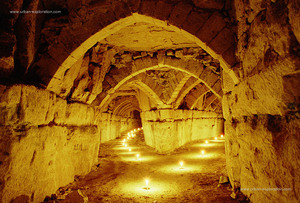imported document on the site 2010-08-16 and amended for the last time 2010-08-22
Quarries of Herblay are over 14km wide and some hundreds of meters deep, on hillsides along the Seine.
In 1776, the exploitation of new underground quarries in Paris was forbidden. People had to take the stone elsewhere. It is for this reason that the quarry was known as "Imperial quarry" or "Quarry of the city of Paris". They built many monuments in Paris with this stone because it was high quality (the famous Royal stone).
Among the monuments built, there was The Pantheon of Paris, Department of Marine Place de la Concorde, the Gare de l'Est, the mint as well as many statues at Versailles.
The network's quarries has been excessively exploited in Herblay. The ceiling is fragile and the walls separating the tunnels are very thin. To reinforce the quarry, they have added many pillars and reinforcement structures.
Later, like many underground quarries, they served to mushroom plantation in the 1980s. The workers have dug additional corridors between small quarries networks.
A few years later and they were gradually abandoned. The latest mushroom plantation closed in 1995.
Since 2003, the association "Herblay heritage" has undertaken to make public visits to the part of the "English entry" with the famous double-arched vault and pretty ponds.
In 1776, the exploitation of new underground quarries in Paris was forbidden. People had to take the stone elsewhere. It is for this reason that the quarry was known as "Imperial quarry" or "Quarry of the city of Paris". They built many monuments in Paris with this stone because it was high quality (the famous Royal stone).
Among the monuments built, there was The Pantheon of Paris, Department of Marine Place de la Concorde, the Gare de l'Est, the mint as well as many statues at Versailles.
The network's quarries has been excessively exploited in Herblay. The ceiling is fragile and the walls separating the tunnels are very thin. To reinforce the quarry, they have added many pillars and reinforcement structures.
Later, like many underground quarries, they served to mushroom plantation in the 1980s. The workers have dug additional corridors between small quarries networks.
A few years later and they were gradually abandoned. The latest mushroom plantation closed in 1995.
Since 2003, the association "Herblay heritage" has undertaken to make public visits to the part of the "English entry" with the famous double-arched vault and pretty ponds.

